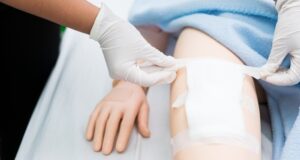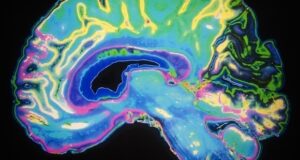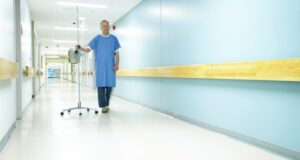
Thanks to Glenn, tour guide extraordinaire, for this picture of the Forbidden City! (Yes, it was cold.)
Here are some observations from a recent trip to China, a country I’d never visited before. It was an 8-day trip related to my editor role at Clinical Infectious Diseases (there is a Chinese edition) and my particular area of focus within Infectious Diseases (HIV), so I’ll start with some epidemiology and medical stuff and wrap up with some non-medical observations.
Big picture — it’s an amazing country, well worth visiting, with dynamic city life, historic sites, incredible food, and so many people. Very grateful for the opportunity to visit.
Two caveats ahead of time — this was just one trip, an “academic exchange,” with lectures and hospital visits. So my experience can hardly be considered fully representative of this complex and giant country. Second, that 13-hour time difference scrambles the brain a bit, so it’s possible (likely) I got some of this wrong. Corrections welcome from the true China experts out there!
Medical and Epidemiology Section
Over 1.4 billion people live in China — that’s over a billion more than in the USA (334 million), in a country roughly the same geographic size. Must keep that in mind when interpreting any epidemiologic data.
China lost the “most populous country in the world” title recently to India, which just edged it out. Population growth has stopped, even after the end of the one-child policy. Like many prosperous nations, young adults in China don’t want to have big families anymore.
China still has just over 100,000 new HIV diagnoses a year. If you think about our 38,000 new cases/year in the USA, and adjust for our respective country’s populations, their incidence appears to be similar to ours, perhaps a bit lower.
Sexual transmission of HIV dominates the current China HIV epidemic in most regions. People told me it was, like the USA, predominantly in men who have sex with men — but it’s hard to find this information in official figures. It’s an enigma!
Despite a big scale-up and wide availability of HIV testing, the late diagnosis of HIV remains a huge problem. Approximately a third of new HIV cases are diagnosed when the CD4 cell count is < 200. As a result, they still have plenty of people diagnosed during a hospitalization for opportunistic infections.
The spectrum of opportunistic infections they see includes the full range of bacterial, fungal, mycobacterial, and viral pathogens. One difference is that southern China is an endemic region for Talaromyces, which is quite uncommon in North America.
There’s very little use of PrEP. This is a big opportunity for HIV prevention, as late HIV diagnosis means not just symptomatic HIV disease and opportunistic infections, it also implies many years of potential HIV transmissions prior to getting on suppressive HIV therapy.
The doctors in clinical practice are unbelievably busy, busy in ways we could never endure in the USA. Doctors told me that some days they saw 50 or more patients. Overnight shifts in the hospital had similar numbers.
One Chinese doctor cited a visit to the USA where she heard doctors complain about being too busy with an HIV clinic that had 10 patients scheduled during an afternoon in clinic. She found that highly amusing.
(Hey — I’d find that busy too!)
The incredibly high demand for medical services, and the required brevity of the clinical visits, has engendered a strain between doctors and patients, and plenty of distrust. Several people mentioned this to me.
The government provides ART and laboratory monitoring for all people with HIV. This includes standard lab tests and more sophisticated molecular tests, if indicated.
The default government-supplied first-line treatment is a four-pill tenofovir DF, lamivudine, and efavirenz regimen. (The efavirenz comes as two 200 mg pills.) This is why a randomized clinical trial comparing it to BIC/FTC/TAF was ethical — efavirenz-based therapy is still standard of care in China.
People can pay to get integrase-inhibitor based first-line regimens that include either bictegravir or dolutegravir. The price is much lower than in the USA.
Transmitted HIV drug resistance is a growing problem. Not surprisingly, it’s NNRTI resistance that’s the issue, which is exactly what happened here in the 2000s.
Non-Medical Section
Cash in China is gone. Everyone pays for things electronically. This is true in the fanciest hotels, shops, and restaurants, at the humblest street stalls selling inexpensive souvenirs, marinated tofu rolls, and chili noodles, and everything in between. The only “cash” I saw was a replica of a bill on a decorative airline ticket.
An app does everything. That app is WeChat — it pays for things, yes, but so much more. It also consolidates your spending history, chats, shared photos, locations, call records, probably your dog’s birthday. It’s all there in one multi-purpose location.
The government monitors everything, and everyone knows this. That includes, of course, WeChat. Sure must make it convenient for them to see what you’re up to!
Cameras are everywhere. I walked into a hotel for a meeting, one I wasn’t staying at, and a camera quickly picked up my face in the elevator, projecting it on a screen next to the number pad and highlighted it.
 The cities I visited were unbelievably clean. I visited Guangzhou, Hangzhou, and Beijing. These are big cities, with plenty of people and high population density. You’d think that would lead to plenty of garbage on the streets and overflowing trash cans, but I saw zero of both. It was wonderful.
The cities I visited were unbelievably clean. I visited Guangzhou, Hangzhou, and Beijing. These are big cities, with plenty of people and high population density. You’d think that would lead to plenty of garbage on the streets and overflowing trash cans, but I saw zero of both. It was wonderful.
(Quick aside: Interesting contrast to my hometown New York, where bags of garbage are put out on the street on a regular basis, and trash bins are few and far between or over capacity — or non-existent! New York’s garbage certainly must be quite a shock for visitors from China.)
The cities are unbelievably safe. It was wonderful (again). I strolled down some packed pedestrian passages, brimming with people looking at shops, tasting street food, watching the occasional public dancing group. I asked the person I was walking with — who was wearing his backpack on his back — if he ever worried about pickpockets. “Doesn’t happen here,” he said.
(Another aside — Barcelona is one of my favorite cities in the world. But can you imagine how long your wallet or cell phone would last in your backpack if you wore it on your back on Las Ramblas?)
The quality of rail travel — subways and high-speed trains — is light years better than ours. Public transportation is very affordable and (not surprisingly) very crowded. The airports are gleaming and efficient.
Car traffic in the big cities is quite dense (like ours) but exacerbated by an enormously wide range of vehicles (cars, trucks, scooters, mopeds, bicycles both manual and electric) using the same roads. Seems like half the cars are electric (green license plates), featuring many brands not available here.
Tourist sites are very popular, with most of the tourists Chinese — book ahead! And don’t be fooled by the “empty” look of the Forbidden City in the picture at the top of this post — that was due to the skilled photography work of Glenn, my erudite tour guide, who knew the perfect vantage point for every photo. The place is huge, by the way — that picture is probably 10% of the total area.
Intense security is part of the process of entering famous sites. Don’t forget your passport, which will be scanned or at the very least reviewed.
Tea is ubiquitous. This is the drink that accompanies every meal.
Starbucks is ubiquitous. This and the previous comment are not oxymorons. Tea is for meals, Starbucks for other times of day. In all of my foreign travels, I have never seen a higher density of this chain. There are nearly 8,000 Starbucks in China, and the number has grown fast. Not surprisingly, domestic coffee production has risen up as a competitor.
If you ask for water at a restaurant, it will be hot. Granted, I was there in the winter. But I was told this is typical year-round. It’s actually quite pleasant once you get used to it.
Restaurant meals have no “courses.” The food comes out when it’s ready, even when there are multiple dishes to be shared.
If there’s tipping at hotels, restaurants, or taxis, I didn’t see it. They assume the payment is also for the service. Gosh, that’s a better system.
Family ties are ironclad. Grandparents, children, and grandchildren all occupy the center of life — even if it means lots of travel to make it work and living situations that could strain privacy. Multi-generational households are the bedrock of social life in China.
The work ethic and ambition of young professionals is off-the-charts high. Conversations invariably included numbers of hours worked, salary targets, and promotion goals — plus an acknowledgment that there would be no short cuts to success.
I traveled through Hong Kong on my way and was surprised to learn that people need an “Entry Permit” (EEP) on their Chinese passport to enter the region from mainland China — even today, 27 years after the transfer to Chinese sovereignty.
The control of the internet is a real thing. Google, YouTube (owned by Google), most social media, and the vast majority of western news sites are blocked. There is an English-language, China-sanctioned version of CNN that is available online and on television. Interesting to observe what news is given the go-ahead.
They are enormously proud of the economic progress and poverty alleviation their country has made in the last several decades. They also expressed, at least to me, admiration for resources that our country offers. Several mentioned family members who studied or worked in the USA.
MLB in China stands for “Major League Baseball,” but not really. It’s a fashion label first and foremost. And New York Yankees and Los Angeles Dodgers logos dominate (90% of the team insignias, based on my quick tally). To the Red Sox and Giants fans out there, don’t worry — they are fans only of the logos, not the teams!

It was a fascinating trip — looking forward to going back!
(H/T to Joseph Tucker, Jonathan Li, and Kevin Zhang for helpful feedback on this post, and enormous thanks to the organizers of my trip and my medical hosts who made it possible.)




